Sun’s Up!!!
Today is a beauty! The sun, the full round ball of burning spewing gases, was up in the sky around 0830 (so I’m told) and it stayed up there almost til 4 (again, heresay where was I??). We are about 30 miles from land, can almost see it, except for some low clouds in that direction, and we have only one full day to go at sea. Plankton operations are still in full swing, dropping a net about every 15 miles until tonight around 8p. There have still been only a few larvae, but until the chocolate and ginger cookies stop coming, the team is dedicated.
Before Electronics Using a Sextant
Why use it? “If a wave came crashing through the Bridge windows and wiped out all of these nice electronics on the control panel”, said Captain Marty Galster, “you’d have to have another way to find your way home. Plus, it’s fun”. There’s nothing like the sextant and heavenly bodies to refer back to. Captain Galster took out the ship’s sextant, a beautiful and sturdy black instrument with a surface like satin and optics clean and polished, kept in a protective wooden case. He showed me how a sighting, or ‘altitude’ is taken on 1) a ‘heavenly body’ the sun in this case and 2) the horizon. While looking through the eyepiece, a knob at the base is turned, affecting the optics so that the two appear to get closer to one another. When the bottom of the sun ‘touches’ the horizon, a measurement is read in degrees from a curved bar near that knob this measures angle in degrees of the sun above the horizon. Precise time of reading is recorded, and then the calculations begin. There are 2 resource texts used: One (The Nautical Almanac) gives the exact ‘address’ of the sun (or one of several other ‘heavenly bodies’ if you are doing a reading at night) on an imaginary ‘celestial sphere’ that surrounds the earth, a construct that navigators use to make both the math and the concepts a little easier. The ‘address’ has to be calculated for the precise (to the second) time of day, as the earth is rotating and thus the sun, planet and stars are constantly moving relative to an observer on earth. By knowing the angle you are to the sun (via the sextant) and the time of day, and that ‘address’ of the sun all at the same time, plus a few other calculations related to inherent ‘error’ of the instrument, refraction (bending) of light in the atmosphere and how high off the surface of the sea you are, you can use the second resource (the Sight Reduction Tables) and where you thought you were in the first place (Sextant is Lesson 2; Lesson 1 is Dead Reckoning) ….to find out where you are on earth. All this, without that electronic stuff helping you. Bah! on that!!! Well, of course, it is more complicated than I can either comprehend at the moment, or put into a paragraph, but I can tell you that it all made sense at the time. Celestial navigation is a required certification for a ship’s captain, to assure success of navigation in the event of an electronics failure. It is also humbling to see that this was figured out and documented a long, long time ago, when a navigator had only his/her imagination, intellect and power of deduction to work with, and it became necessary to do more than hazard a guess… [Thanks, Marty for helping me write this very abbreviated description on a complex but fascinating process.]
Historical Side Note: The ‘Sight Reduction Tables’ mentioned above are actually a six volume set of large, heavy books that together stack more than a foot and a half high laid flat on a chart table. They are essentially a tabular calculator for spherical trigonometry in book-form. They came into being in the 1930’s when the government employed out-of-work mathematicians and their slide rules to perform the hundreds of thousands of calculations required to compile these tables. Decades later, the results were run through a computer to check for errors, and it was discovered that none were made.
Getting To Know You
Why I Became A Marine Biologist
I asked the younger set to share with you how they decided to become a Marine Biologist (couldn’t ask the adults, because they’re at the stage where they just answer “I’m asking myself that very question daily.”)
Nicole Cox
My first glimpse of the ocean was when I was in elementary school. I didn't get the chance to visit again until I was in high school. However, shortly after that first visit I knew that I wanted to have a career dealing with the ocean. Everything about it was such a mystery to me. The fact that I didn't visit again for so long only fueled that desire because I knew a career with it was one sure way to get back to it someday. I haven't changed my mind since then and continue to pursue that dream. It wasn't until my 7th grade year that I decided on biology. It was my first biology-related class and I loved everything I learned about. So I combined the two to end up where I am now. I was very lucky to learn my interests so early in life. However, until recently my interests were very broad. Only a year and a half ago did I narrow down my interests to invertebrates, especially echinoids (sea urchins).
Nerida Wilson
I had always enjoyed being by the ocean, and looking at whatever creatures washed up in the tides. As a kid, I enjoyed shell collecting, and as I got older, I decided to learn to SCUBA dive, so I was not reliant on looking at only animals that lived in tide pools or at snorkelling depths. Once I started SCUBA diving, I became vastly more interested in how animals lived; what they ate, how they reproduced and how they avoided becoming eaten themselves. I went to university and took as many invertebrate classes that I could. I decided to do a general science undergraduate course, to keep opportunities open if I became interested in other fields of science. But meanwhile, I volunteered for different marine groups and researchers to gain as much experience as possible. This was a really important way to gain skills and to get to know other people working in the field, and it led to many opportunities later on. For graduate work, I finally began to specialise in the group that interested me the most- sea slugs!
Rebecca Hunter
My first significant experience with the marine environment was as an undergraduate at Abilene Christian University during my Marine Biology course. In addition to regular lectures, the course also included a week of SCUBA diving off the Bay Islands of Honduras. After spending a semester learning about the marine environment and a week of diving, exploring tide pools and mangrove swamps, I was hooked. With the help of one of my undergrad professors, I decided I wanted to go to graduate school and pursue a career as a research scientist where I could combine my interests in both field and laboratory work.
[Ed. Note: This is Rebecca’s second cruise to Antarctica, and she also did field work for one month at McMurdo Station near the South Pole where she was a participant in the NSF-sponsored Antarctic Biology course. The course is intended to train PhD students, post-docs and junior professors in all aspects of the biology of organisms living in the Antarctic, and to give these scientists some experience conducting research in the Antarctic so they will be better equipped to do so on their own in the future.]
Alexis Janosik
St. Louis, Missouri isn’t exactly the place to “grow” a Marine Biologist, but family vacations to the sure beach are! When I was around the age of 7 or 8, my family was vacationing on Hilton Head Island, South Carolina. One afternoon, my parents signed us up for a guided beach walk. The guide took us up and down the beach pointing out things both small and large and he immediately captured my attention. Specifically, I remember that he explained sea stars, egg cases, crabs, sea weed and many other animals that live in the tide pools. On this day my interest in the marine world was sparked and has continued ever since. Throughout middle school and high school my interest grew as I read as many “About the Ocean” books as I could get my hands on and also, attended Marine Career Camps, week long events that expose you to the field of Marine Biology. With this and support from my parents, my interest grew and led me to Auburn University, where I am still carrying out my dream!
Back to the Science
The final of 75+ plankton tows were performed today. There is now a complete sampling of the Drake Channel, as well as complete XBT transect a successful science passage with calm seas to boot!!
After Dinner Talks: 3 speakers describing their main courses of study
Diego Giberto
Diego is studying the importance of boundary ecosystems in benthic communities. He described the ecology of 6 species of fishes in estuarine waters, including predation, niche partitioning, dispersion and tolerance to environmental gradients.
Andy Mahon
Andy is finishing his dissertation and shared with us his passion for a fish called Perciformes, just one of 24,600 species of fish the largest order of vertebrates on the planet. He was enthusiastic and focused and I wish I could have stayed for the whole thing.
Alexis Janosik
Alexis is working on future projects for grad school using molecular phylogenetics to study Antarctic sea stars.
[EDITOR'S NOTE: I will be writing one more journal while at sea, #33, tomorrow June 13th. The Final Journal, #34, will be written once I'm back in Woods Hole, so stay tuned for that final entry. Thank you all for 'listening' and watching while we had the experience of a lifetime way down in Antarctica!!]
|
|
Longitude/Latitude:
S56° 02.920’ W64° 38.962’
Temperature:
Wind: SSE 11-13kn
Seas 6 ft
Air Temp: 2.5°C
Wind Chill: -7.9°C
Surface Water Temp: 5.030°C
Menu:
Meatloaf, fish, potato, spinach, rice, soup, fresh bread; flan, peach nut bread, pecan pie, and cookies.
Photos:
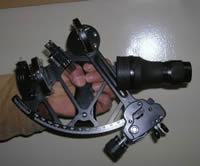
L.M.G.’s resident sextant
[Also provided by Marty Galster]
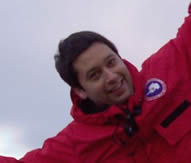
Diego Giberto
[Photo by Chris Mah]
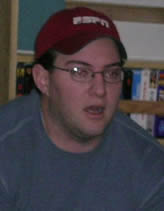
Andy Mahon
[Photo by Ellen Bailey]
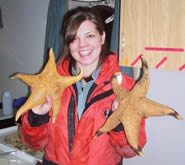
Alexis Janosik
[Photo by Diego Giberto]
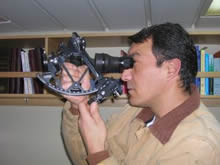
Guillermo Pizarro demonstrates the handling of the sextant. [Photo by Ellen Bailey]
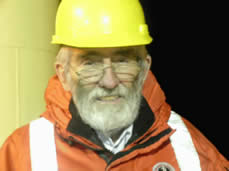
Rudi Scheltema out on deck for the Last Plankton Tow of the cruise. [Photo by Ellen Bailey]
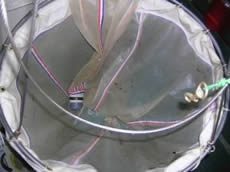
The last look at the last net from the Last Tow of the Cruise!
[Photo by Ellen Bailey]
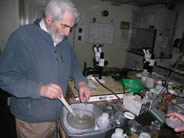
Rudi, hands on as always, sorting the last plankton tow of this cruise. [Photo by Ellen Bailey]
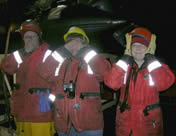
…and your opinion on the daily scheduling of trawls and tows???
[Will Jaeckle, Janis Umschlag and Pam Polloni. Photo by Ellen Bailey]
And Back to Nature, with 3 photos by Jack Baldelli:
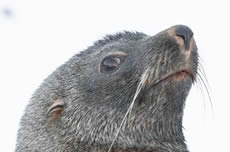
Fur seal, showin’ some attitude.
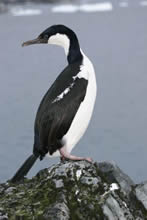
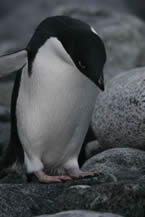
Top: I may be beautiful, but I’m still a……Cormorant
Bottom: Now this little Adelie is easy to love
|













